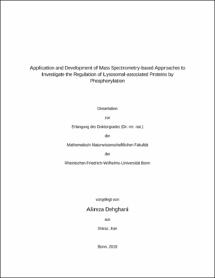Dehghani, Alireza: Application and Development of Mass Spectrometry-based Approaches to Investigate the Regulation of Lysosomal-associated Proteins by Phosphorylation. - Bonn, 2019. - Dissertation, Rheinische Friedrich-Wilhelms-Universität Bonn.
Online-Ausgabe in bonndoc: https://nbn-resolving.org/urn:nbn:de:hbz:5-56113
Online-Ausgabe in bonndoc: https://nbn-resolving.org/urn:nbn:de:hbz:5-56113
@phdthesis{handle:20.500.11811/8091,
urn: https://nbn-resolving.org/urn:nbn:de:hbz:5-56113,
author = {{Alireza Dehghani}},
title = {Application and Development of Mass Spectrometry-based Approaches to Investigate the Regulation of Lysosomal-associated Proteins by Phosphorylation},
school = {Rheinische Friedrich-Wilhelms-Universität Bonn},
year = 2019,
month = nov,
note = {Phosphorylation is one of the most abundant and best studied posttranslational modifications in mammalian cells and refers to the addition of a phosphate group to an amino acid residue of a protein. Phosphorylation can alter protein stability, interaction with other molecules, activities, and sub-cellular location. Therefore, it has a significant role in numerous cellular functions such as signal transduction, cell differentiation, growth, and apoptosis. In order to better understand the role of phosphorylation in biological systems, different techniques and workflows have been developed in recent years to conduct phosphoproteomic analyses. In this thesis project, by using a novel workflow, regulation of lysosomal-associated proteins by phosphorylation was examined. In the first chapter of the thesis, a phosphoproteomics workflow was developed and optimized, which was applied for the phosphoproteomic investigation of cholesterol metabolism with emphasis on lysosomal proteins described in the second chapter.
In chapter one, the aim was to establish a robust, easy, and time-efficient method for large-scale phosphoproteomic studies. A common strategy in such studies is the fractionation of large amounts of peptides followed by enrichment for phosphopeptides from the resulting fractions. Fractionation followed by enrichment is a time-consuming and expensive process and requires specialized equipment and operators. In this chapter, a method was developed which addresses these problems by optimizing the workflow to batch-enrichment of phosphopeptides followed by their fractionation using in-house manufactured tip columns. This allows for cost- and time-efficient identification of large quantities of phosphopeptides without specialized equipment.
In the second chapter, the newly established phosphoproteomics workflow was employed to investigate phosphoproteome alterations in cells with perturbed cholesterol metabolism system. Using the stable isotope labeling with amino acids in cell culture (SILAC) method, mouse embryonic fibroblasts (MEFs) were labeled and treated with either U18666A (cholesterol transporter inhibitor) or DMSO (control). A large-scale phosphoproteomic experiment was performed using the labeled cells, and in total, 12881 phosphosites were identified and quantified. Six lysosomal or lysosomal-associated phosphoproteins containing differentially expresse d phosphosites (LAMTOR1, RagC, OSTM1, STARD3 STARD3NL, BNIP3, and VAMP8) were selected for further investigations. The follow-up experiments suggested that LAMTOR1 phosphorylation abolishes its interaction with other proteins such as Rag GTPase complex members and SLC38A9. Moreover, it was shown that OSTM1 phosphorylation promotes its cleavage.},
url = {https://hdl.handle.net/20.500.11811/8091}
}
urn: https://nbn-resolving.org/urn:nbn:de:hbz:5-56113,
author = {{Alireza Dehghani}},
title = {Application and Development of Mass Spectrometry-based Approaches to Investigate the Regulation of Lysosomal-associated Proteins by Phosphorylation},
school = {Rheinische Friedrich-Wilhelms-Universität Bonn},
year = 2019,
month = nov,
note = {Phosphorylation is one of the most abundant and best studied posttranslational modifications in mammalian cells and refers to the addition of a phosphate group to an amino acid residue of a protein. Phosphorylation can alter protein stability, interaction with other molecules, activities, and sub-cellular location. Therefore, it has a significant role in numerous cellular functions such as signal transduction, cell differentiation, growth, and apoptosis. In order to better understand the role of phosphorylation in biological systems, different techniques and workflows have been developed in recent years to conduct phosphoproteomic analyses. In this thesis project, by using a novel workflow, regulation of lysosomal-associated proteins by phosphorylation was examined. In the first chapter of the thesis, a phosphoproteomics workflow was developed and optimized, which was applied for the phosphoproteomic investigation of cholesterol metabolism with emphasis on lysosomal proteins described in the second chapter.
In chapter one, the aim was to establish a robust, easy, and time-efficient method for large-scale phosphoproteomic studies. A common strategy in such studies is the fractionation of large amounts of peptides followed by enrichment for phosphopeptides from the resulting fractions. Fractionation followed by enrichment is a time-consuming and expensive process and requires specialized equipment and operators. In this chapter, a method was developed which addresses these problems by optimizing the workflow to batch-enrichment of phosphopeptides followed by their fractionation using in-house manufactured tip columns. This allows for cost- and time-efficient identification of large quantities of phosphopeptides without specialized equipment.
In the second chapter, the newly established phosphoproteomics workflow was employed to investigate phosphoproteome alterations in cells with perturbed cholesterol metabolism system. Using the stable isotope labeling with amino acids in cell culture (SILAC) method, mouse embryonic fibroblasts (MEFs) were labeled and treated with either U18666A (cholesterol transporter inhibitor) or DMSO (control). A large-scale phosphoproteomic experiment was performed using the labeled cells, and in total, 12881 phosphosites were identified and quantified. Six lysosomal or lysosomal-associated phosphoproteins containing differentially expresse d phosphosites (LAMTOR1, RagC, OSTM1, STARD3 STARD3NL, BNIP3, and VAMP8) were selected for further investigations. The follow-up experiments suggested that LAMTOR1 phosphorylation abolishes its interaction with other proteins such as Rag GTPase complex members and SLC38A9. Moreover, it was shown that OSTM1 phosphorylation promotes its cleavage.},
url = {https://hdl.handle.net/20.500.11811/8091}
}






